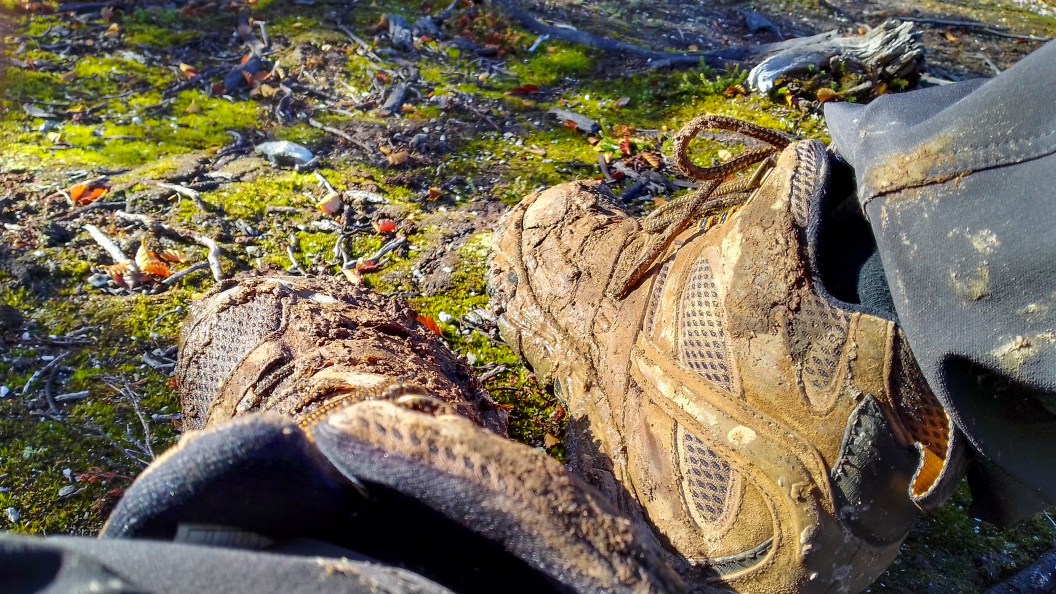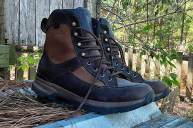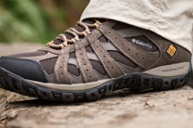Nothing screams "newbie" in the backcountry, farm pasture, or hunting grounds quite like wearing pristine leather boots. Once you build up some mud smears, scuff marks, and sun fading on your cowboy boots or hiking shoes, you start to feel like a bona fide adventurer.
The problem: Without proper TLC, this wear and tear could diminish the lifespan and quality of your leather boots. We talked to footwear pros for this step-by-step guide on how to clean leather boots so they last for many adventures to come.
Why You Should Clean Leather Boots
Cleaning and restoring leather boots isn't just about removing the dirt and grime that's building up on the fabric uppers and outsoles. The primary goal is to prevent the leather from excessively drying. Genuine leather is skin, and it needs to stay hydrated to remain free of cracks, splits, and tears, says Josh McPherson, a retail operations coordinator at Tecovas, a brand known for its high-quality western boots.
However, wearing or storing your boots in the sun or dry air, working in them frequently, and exposing them to dirt can all contribute to drying, which can cause problems down the line. Dried-out leather is not as pliable, a trait that helps your leather stretch as your foot swells throughout the day. Without that flexibility in the fabric, your boots may suffer from tears in the stitching.
5 Steps for Cleaning Leather Boots
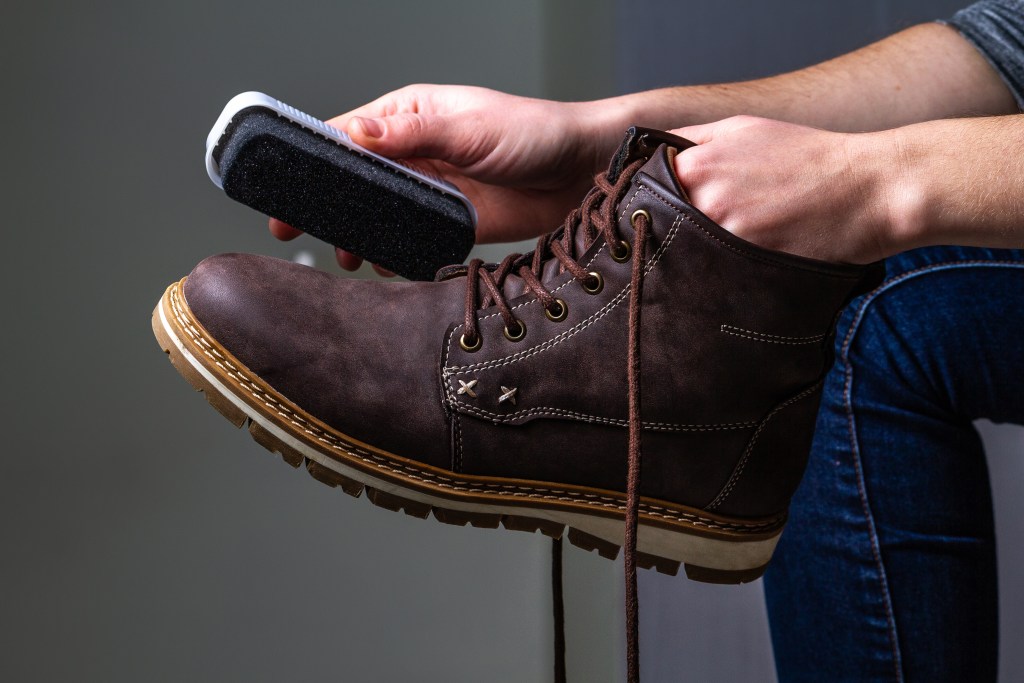
Getty Images, Siarhei Khaletski
Before you start scrubbing dirt off your hiking boots or coating your sun-baked cowboy boots in creams, you first need to know the type of leather you're dealing with, says Jon Sanregret, a product line manager at Merrell. "The common mistake is to clean all leather the same, so make sure you do some product research," he says. Some shoes, such as Merrell's Moab 3s, have both nubuck and suede leather. Others, including many of Tecovas' boots, are made of full-grain leather. Each type of leather requires different products to best maintain the material.
Another insider tip: You shouldn't clean leather boots immediately after you accidentally spill oil or other greasy debris on your footwear. "We love a good rodeo and barbecue situation, but if you accidentally get grease or oil on your boot, you should apply either baby powder, talcum powder, or baking soda immediately," says McPherson. Any other cleaning technique will brush or set in the stain.
In other words, consider the thorough cleansing process to be routine maintenance, not an emergency fix.
What You'll Need to Clean Leather Boots
To clean rubber outsoles on any boot:
- A small, stiff brush or a stick (like a chopstick)
- A mild soap
- A cloth
To clean suede and nubuck leather boots:
- A damp cloth
- An old toothbrush
- A suede eraser (a.k.a. suede block or dry clean bar)
- A suede brush
- Suede cleaner
To clean full-grain leather boots:
- A horsehair brush
- Leather cleaner
- Leather conditioner
- To freshen boots inside:
- Baking soda
- Vinegar
Step 1: Clean Your Outsoles
The rubber outsoles of leather boots—typically found on hiking or work boots—could use a deep clean every so often and should be spiffed up first before you tackle the uppers. "Not only will [this cleaning] make your boots look better, but it will also ensure that you get the optimal grip and traction from the rubber compound and the tread pattern of your outsoles," says Sanregret.
Remove any loose dirt by lightly tapping your boots together or on a hard surface, then use a stick or a small brush to dislodge any stones or sticks trapped between the lugs, suggests Sanregret. Next, scrub your outsoles with water, mild soap or detergent, and a stiff brush, making sure to hit every groove. Finally, rinse the outsoles with water and dry with a cloth.
Step 2: Wipe or Brush the Leather Boots
If you're cleaning suede or nubuck leather boots, tackle caked-on grime, particularly on the leather seams or overlays, with an old, dry toothbrush to whisk it away. Then use a lightly damp cloth to thoroughly wipe down your boots, says Sanregret. Once clear of obvious dirt, open up the boots, remove the insoles and laces, and allow the uppers to fully air-dry, he says.
For full-grain leather, sweep your horsehair brush down the sides of your boots, across the top of the boots (known as the vamp), and along the edges of the outsole, where dust and dirt may be collecting on the stitching, says McPherson. The soft bristles won't scratch the leather and ensure the gunk will not become soaked into the leather in the following steps.
Step 3: Apply a Cleaner and Tackle Stains
For suede and nubuck, you'll need a suede-specific cleaner, as traditional leather cleaners could affect the color and may not properly remove dirt and stains. Spray the product onto your hand or a rag and rub it gently into particularly grimy or stained areas of the boots—not the entire boot. Let the product sit for about 10 to 15 seconds. Then, gently rub your suede eraser in a circular motion over the areas where you've applied cleaner. This fiberglass-infused tool acts as a spot remover, and it can be used dry without your cleaning product to hit stains in between deep cleanings, says Sanregret.
With full-grain leather boots, you'll want to apply a leather cleaner, which helps remove any lingering grime such as embedded dust, dirt, manure, and non-oily stains that the earlier brushing didn't take care of, says McPherson. Apply the leather cleaner to your hands or a cloth, then work the product into the entire boot, pay special attention to stains. Wipe the surface clean with a dry cloth and allow it to dry before proceeding to the next step.
Step 4: Spiff Up the Uppers
Chances are, the nap of your suede or nubuck boots has flatted from everyday wear or the stain-removing process. Now's the time to use the suede brush to re-fluff the material, sweeping the tool across the boot in circular motions. This brushing will also help remove any bits of suede left after the eraser step, says McPherson.
A conditioning step is essential to giving full-grain leather the moisture it needs for an extended life without cracks, says McPherson. Apply the leather conditioner to your hands, then work the product into the entire boot. "Applying it with your bare hands is helpful because the natural oils from your hands actually help to soak the moisture into the leather," he says. Just know that some treatments may slightly alter the color of your boots, adds Sanregret. Avoid applying leather conditioner to suede or nubuck boots, as it may affect the fabric.
In this stage, you can also give your full-grain leather a high-shine look. Working in circular motions, gently rub the horsehair brush over the boot before the leather conditioner fully soaks in, says McPherson. "The friction created by the brushes can really bring out a natural shine that lasts longer than a polish," he notes.
Finally, let your full-grain leather boots sit overnight in a controlled environment to let the cleaners and conditioners fully penetrate the fabric, says McPherson. But "don't dry your boots with direct heat," Sanregret says. "This could compromise the materials used in constructing your boots."
Step 5: Freshen the Insides
This final step helps your leather boots feel just as clean on the interior as they now look on the exterior. Sprinkle a bit of baking soda into the footwear alleviates harsh smells, according to the experts.
If your insoles are removable, you can take them out from your boot and clean them with a mix of vinegar and baking soda. Or swap them out entirely if your bootmaker offers replacements, they say.
The Bottom Line on Cleaning Leather Boots
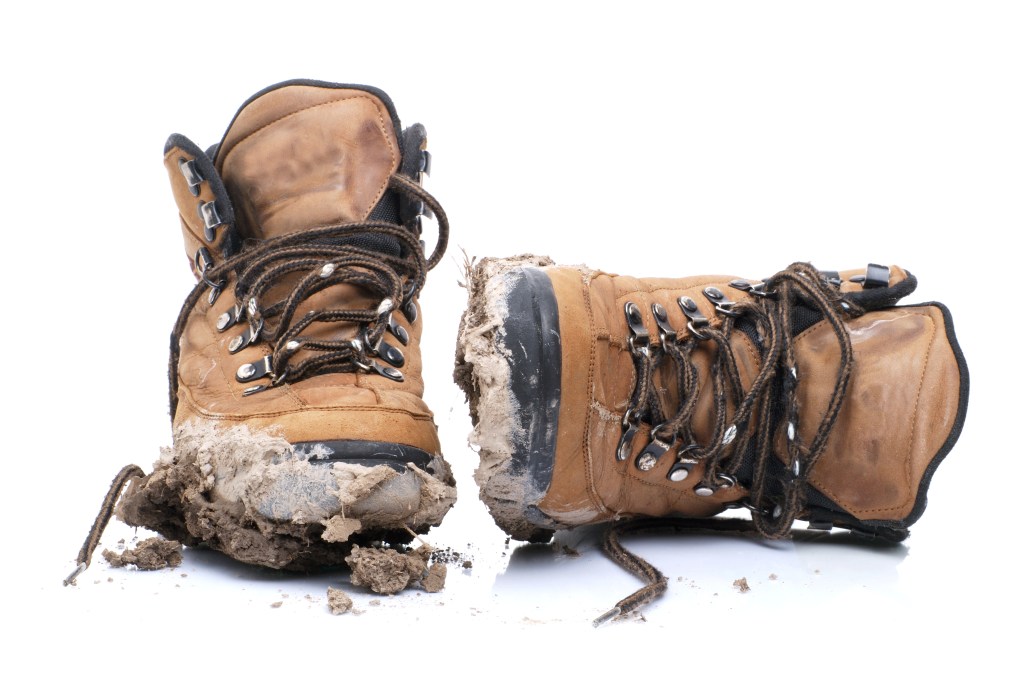
Getty Images, kreinick
Cleaning your leather boots may seem like a long, tedious process, but once you roll up your sleeves and get to work, it can take as little as five minutes, says McPherson. Regardless, refreshing your leather boots is well worth the time and energy. "While there are some people who believe that you never have to clean or condition your boots, there are really only advantages," says McPherson. "You're adding more years to the life of your boots with proper cleaning and conditioning techniques."
There's no set-in-stone timeline of how often you should clean your leather boots. Instead, take a look at the state of your footwear. If you notice excess dust or dirt on the boots, the color fading, the material seeming stiffer, or stretch or crease marks forming, your leather boots could use a cleaning, McPherson says.
But you shouldn't procrastinate: The old pearl of wisdom "an ounce of prevention is worth a pound of cure" couldn't be more true in the case of leather boots. "Cleaning your boots and caring for them regularly can be the best way to preserve them long term," says Sanregret.
